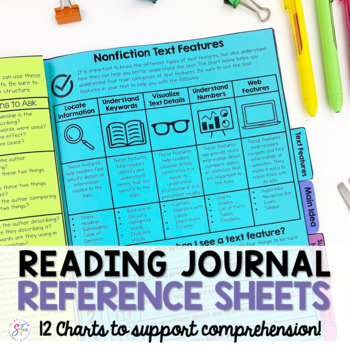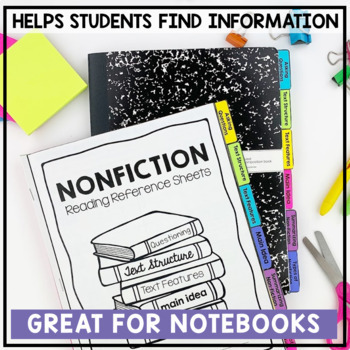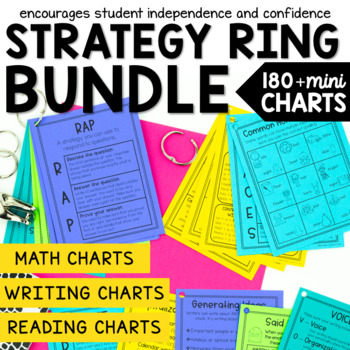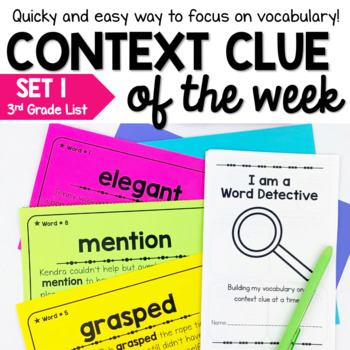These Nonfiction Reading Reference Tabs are the perfect addition to your students’ reading notebooks or journals. Each reference tab includes helpful information about nonfiction texts and will help your students keep their reading notebooks organized… they also work great as a standalone reference booklet.
Nonfiction Reading Comprehension Skills Charts
More about this resource
![]() This resource is included in The Stellar Literacy Collective. Click here to learn more.
This resource is included in The Stellar Literacy Collective. Click here to learn more.
These Nonfiction Reading Reference Tabs are the perfect addition to your students’ reading notebooks or journals. Each reference tab includes helpful information about nonfiction texts and will help your students keep their reading notebooks organized… they also work great as a standalone reference booklet.
Check out the preview to learn more about this resource.
There are a total of 12 reference sheets/tabs. Two for each of the following:
- Asking Questions (Nonfiction)
- Nonfiction Text Structure
- Nonfiction Text Features
- Main Idea
- Summarizing Nonfiction
- Types of Nonfiction
This is ALL the information included on these helpful reference sheets:
- Type of Questions – a chart with an explanation, examples of where to find evidence, and examples of questions for four types of questions (right there, think and search, inferential, on my own).
- Asking Questions Before, During, and After – A list of questions students can ask before, during, and after reading nonfiction texts
- Purpose of Question Chart – A chart with 12 different purposes and examples of questions for each purpose for questioning
- Nonfiction Text Structure Chart – lists each type of text structure, provides an explanation, gives examples of key words, and shows a visual cue reminder
- Multiple Structures – provides students with a checklist of things they should do when they encounter a text with more than one text structure.
- Text Structure Examples and Questions – provides a written example of each type of text structure and includes questions students could ask when they see that text structure on their own
- 5 Categories of Text Features – provides a chart with examples and explanations for 5 ways text features can be used (to make words pop, to locate information, to visualize details, to highlight important numbers, web features)
- 4 Steps to Analyzing Text Features – provides a 4 step process for what students should do when they see a text feature in their text (scan and preview, study, question, evaluate)
- Text Feature Chart – Includes a chart with a list of common text features. Provides a definition of the text feature and includes questions to ask when students see that text feature in their own text.
- Finding Main Idea – provides 4 strategies students could use to identify the main idea of a text.
- Topic, Main Idea, Details Chart – explains the difference and relationship between the topic, main idea, and details in the text. Gives an example of each and shows students what to look for to identify them in their own texts
- Summarizing Nonfiction – a chart that shows what a nonfiction summary is and what it isn’t
- Summarizing Nonfiction – a chart that shows what to pay attention to, questions to ask, and how to organize your thinking to help summarize nonfiction text
- 6 Traits of a Nonfiction Summary – provides a brief explanation of the six attributes that make a clear nonfiction summary (keep it short, state the main idea, include a few details, include the author’s purpose, mirror the text structure, use your own words)
- Summarizing Nonfiction Strategies – includes a chart with 4 strategies students can use to help them summarize nonfiction texts (TAMKO, 5W questions, Text Structure Summary, Summarizing Sections)
- Types of Nonfiction – includes a chart that explains the difference between biographical, reference, and narrative nonfiction
- DEAL strategy – helps students understand how to describe, explain, and compare and contrast relationships in nonfiction texts
- Author’s Purpose – gives students a set of questions to consider when thinking about the author’s purpose for writing nonfiction text
- Firsthand and Secondhand Accounts – provides an explanation and examples of firsthand and secondhand accounts.
How could I use this resource:
- Use them during small group instruction
- Let students refer back to them during independent reading
- Send home to parents so they know everything that students need to understand about nonfiction
_____________________________________________________
Copyright © The Stellar Teacher Co. LLC
www.stellarteacher.com
Permission to copy for single classroom use only.
Please purchase additional licenses if you intend to share this product.












